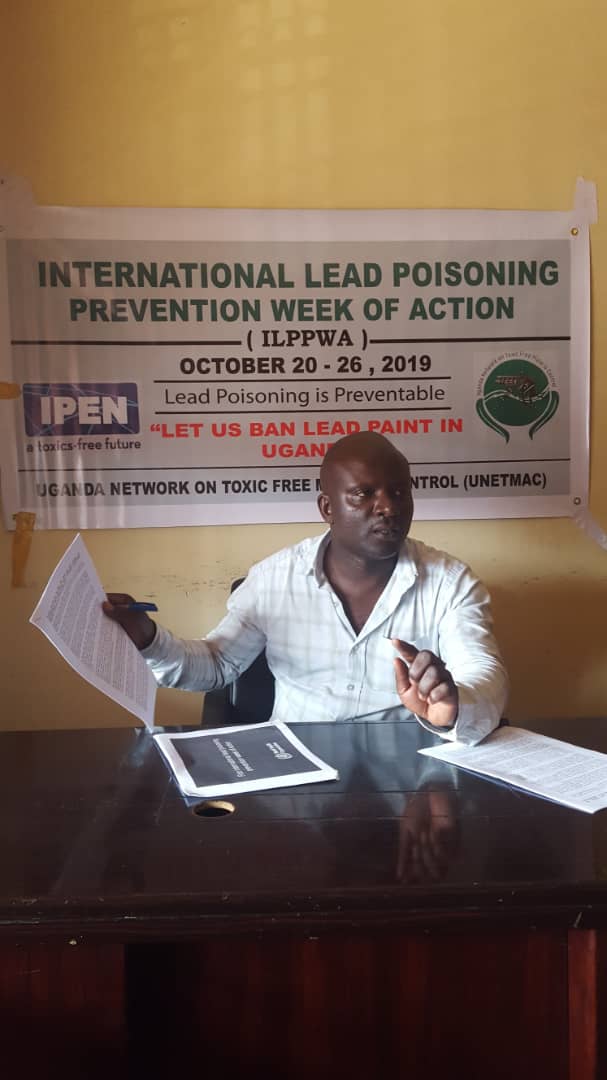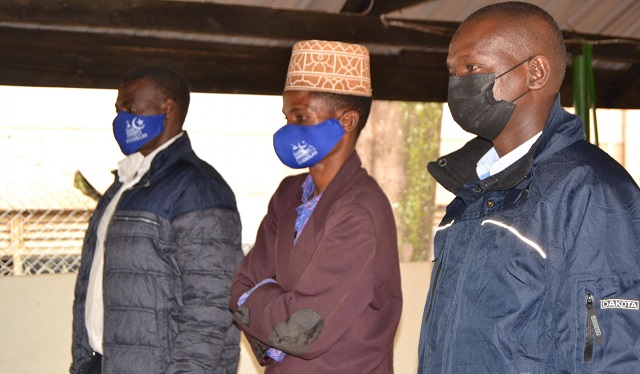Why Uganda should join campaign against lead paint poisoning
The Uganda Network on Toxic Free Malaria Control (UNETMAC), a non- for profit, non- governmental organization (NGO) in Uganda has joined the rest of the world in calling upon the people of Uganda to join efforts in eliminating lead paint.
This call was made by Ellady Muyambi, the Secretary General of UNETMAC while addressing the press in Kampala whose participants included paint manufacturers, paint retailers, occupational workers in paint industries, people involved in (decorative) painting indoors, NGOs involved in environmental and health research and campaign, media personnel reporting on environmental health issues, researchers and academicians, policy makers and technical officials of the Ministries of Environment, Health, Trade and Industry among others.
Muyambi noted that the International Lead Poisoning Prevention Week of Action (ILPPWA) was initiated by the Global Alliance to Eliminate Lead in Paint (GAELP) from 20-26 October as the campaign week specifically to raise awareness about lead poisoning including highlighting the sources of lead exposure, highlight efforts to prevent childhood lead poisoning and to urge further action to eliminate lead paint.
Muyambi further noted recent studies conducted by UNETMAC, and the National Association of Professional Environmentalists (NAPE) in Uganda have confirmed that some paints in Uganda including varnishes, lacquers, stains, enamels, glazes, primers or coatings contain lead content which exceed the US Standard of 90ppm, and that a review of the lead poisoning regulations in Uganda confirm the absence of the regulatory framework for lead poisoning.
He for instance revealed that in 2012, UNETMAC in collaboration with the Occupational Knowledge International (OK International) and the Chemistry Department at Makerere University, collected, prepared and tested 100 white paint samples from eight brands from the Ugandan market for lead content and that three out of the eight brands were found to contain significant concentrations of lead, ranging from 2200-7700 ppm.
In 2016, UNETMAC also participated in the collection of paint samples under the IPEN project implemented by the National Association of Professional Environmentalists (NAPE).
Dr. Ogaram David Akuban, a renowned chemical consultant revealed that lead paint or lead-based paint is paint containing lead.
Dangers of lead
Lead is added to paint to accelerate drying, increase durability, maintain a fresh appearance, and resist moisture that causes corrosion and that the U.S government defines "lead-based paint" as any "paint”, surface coating that contains lead equal to or exceeding one milligram per square centimeter (1.0 mg/cm2) or 0.5% by weight."
Dr. Ogaram further noted that lead is a highly cumulative toxic metal that can cause serious health problems if it's ingested or if dust containing lead is inhaled and that over time, paint-coated surfaces wear, deteriorate and chip.
If there is lead in the paint, the lead contaminates indoor dust and outdoor soil.
And that, adults are exposed to lead during construction and or during routine maintenance while young children get exposed to lead when they put their hands or other lead-contaminated objects into their mouths, eat paint chips found in homes with peeling or flaking lead-based paint, chew paint that flakes off walls and woodwork or play in lead-contaminated soils and or mouth lead-painted toys and furniture.
Young children below the age of 6 years absorb lead more easily, and it's more harmful for them than it is for adults and older children. It was noted that at high levels of exposure, lead attacks the brain and central nervous system to cause coma, convulsions and even death.
 Ellady Muyambi addressing the press
Ellady Muyambi addressing the press
Lead exposure is linked to elevated blood pressure, reduced cognitive potentials, reduced foetal growth and lower birth weight, economic loss and is associated with at least, 674,000 deaths per year globally and that children who survive severe lead poisoning may be left with mental retardation and behavioural disorders and further that low levels of exposure to lead can cause health effects such as learning disabilities and behavioural problems in children.
Revealed also was the fact that the US Environmental Protection Agency (EPA) and the Centres for Disease Control and Prevention (CDC) agree that there is no known safe level of lead in a child's blood.
Lead stays in the blood for several months and it can be stored in the bones for 30 years or more. The more lead you are exposed to, the more likely you are to get lead poisoned.
From the legal perspective, Counsel Frank Taremwa from the government noted that although many developed countries such as the US, Canada and UK among others have regulations prohibiting the use of leaded paint for domestic/household use as well as public facilities such as schools and hospitals, it is still legal in those countries to use leaded paint for industrial applications.
It is only Philippines which have a regulation on lead content of both residential and industrial paint.
Vital to note was the revelation that after the phase-out of leaded automotive fuels, lead in paint is now one of the largest and widespread sources of lead exposure today especially to young children and pregnant women and that the United Nations Environment Programme (UNEP) has been engaged in action to address the environmental and health risks posed by lead, focusing to date on the phasing out of lead in fuels and paints.
Noted also was that fact that, at the World Summit on Sustainable Development in 2002, governments called for lead paint to be phased out and that in 2011, UNEP, in cooperation with the World Health Organisation (WHO), supported the formation of the Global Alliance to Eliminate Lead Paint (GAELP), a global partnership aiming at promoting the establishment of lead paint laws to ban the use of lead in paint by 2020.
The Institute for Health Metrics and Evaluation has estimated that in 2017 lead exposure accounted for 1.06 million deaths and 24.4 million years lost to disability and death due to long-term effects on health, with the highest burden in developing regions.
For instance, in Uganda, it is still legal to sell lead paint for use in homes, schools, hospitals, churches, and other buildings.
UNETMAC therefore called upon paint companies in Uganda to begin voluntary measures to reformulate and to stop adding lead compounds into their paint products.













